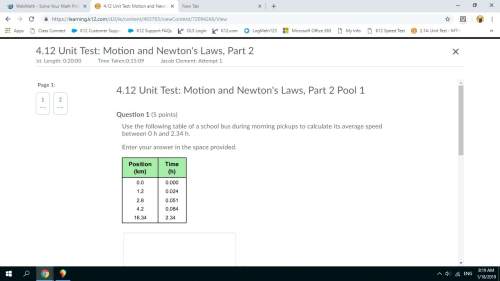
Physics, 06.02.2020 01:41, adanaguirre17
In a physics lab experiment, you release a small steel ball at various heights above the ground and measure the ball’s speed just before it strikes the ground. you plot your data on a graph that has the release height (in meters) on the vertical axis and the square of the final speed (in m2/s2) on the horizontal axis. in this graph your data points lie close to a straight line. (a) using g = 9.80 m/s2 and ignoring the effect of air resistance, what is the numerical value of the slope of this straight line? (include the correct units.) the presence of air resistance reduces the magnitude of the downward acceleration, and the effect of air resistance increases as the speed of the object increases. you repeat the experiment, but this time with a tennis ball as the object being dropped. air resistance now has a noticeable effect on the data. (b) is the final speed for a given release height higher than, lower than, or the same as when you ignored air resistance? (c) is the graph of the release height versus the square of the final speed still a straight line? sketch the qualitative shape of the graph when air resistance is present.

Answers: 2
Other questions on the subject: Physics


Physics, 21.06.2019 23:00, POOPINgligma
Atrain departs from its station at a constant acceleration of 5 m/s. what is the speed of the train at the end of 20s?
Answers: 1

Physics, 22.06.2019 06:30, haha81
Which of these statements is true? a. quarks pair with leptons to form protons and neutrons. b. quarks pair with bosons to form photons. c. quarks pair with photons to form protons and neutrons. d. quarks pair with other quarks to form protons and neutrons. e. quarks pair with electrons to form protons.
Answers: 1

Physics, 22.06.2019 08:00, booitsmrradl3385
While studying chemical reactions and conservation of matter, sarah's class conducted a variety of experiments. sarah and her lab partner found the mass of a wax candle and placed the candle in a flask. the students lit the candle and let it burn to completion. all that was left was wax and charred candle wick. per their teacher's instructions, the students found the mass of the products. their data can be seen in the data table. formulate a hypothesis the students could test to explain why the experiment did not support the law of conservation of matter. a) the students could repeat the experiment using different candles; there might have been a flaw in the candle. b) the experiment should be repeatable. the students should run several trials and then take an average of the after mass in each trial. c) the students should have someone in the class check their measurement skills as they repeat the experiment. they may have made an error using the balance. d) the students should burn the candle in a container that has some type of lid so that any gas that is a product of the reaction can be contained and massed. submit
Answers: 2
Do you know the correct answer?
In a physics lab experiment, you release a small steel ball at various heights above the ground and...
Questions in other subjects:


Business, 28.07.2021 14:00


Mathematics, 28.07.2021 14:00


Computers and Technology, 28.07.2021 14:00

Mathematics, 28.07.2021 14:00


Mathematics, 28.07.2021 14:00

Mathematics, 28.07.2021 14:00







